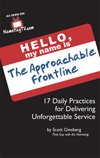 As you recall from my recent post about what smart brands know, “heartshare” is defined as follows:
As you recall from my recent post about what smart brands know, “heartshare” is defined as follows:
The level of emotional responsiveness your work commands.
And when you capture it, engagement ensues, followership grows and loyalty skyrockets.
Today we’re going to explore another collection of ways to make it work for your message, your brand and your organization:1. Bring the funny. Humor isn’t just the universal language – it’s also the great catchall. Think about it:
Funny arrests attention, anchors emotion and guarantees engagement.
Funny indicates listening, enables relaxing and facilitate approval.
Funny builds trust, earns credibility and fosters influence.
And when you bring the funny – not jokes, but the personal, inherent and inescapable funniness of your humanity – an entire symphony of reverberations echoes through people hearts.
Now, most comedians will tell you that it’s all in the delivery. Which is true. I’d also suggest that it’s all in the approach. Because in my experience, if you want to capture greater heartshare, you have to approach humor holistically, not mechanically.
Contrary to what all those superficial, marginally helpful books on communication, leadership, persuasion and storytelling say, you can’t “use humor” like you use hair gel.
Funny isn’t something you add – it’s something you embody.
And the cool part is: Everybody is funny. Everybody has endless humor in his life. And everybody can excavate the constant and inherent hilariousness of his daily experiences.
Which means: If you aren’t funny, you aren’t listening to your life. If you want to capture people’s hearts, there’s no need ventriloquize other people’s humor and pawn it off as your own original material. The fact that you’re a human being is funny enough.
Remember: The quickest path to someone’s heart is through her funny bone. How quickly do people start laughing when they’re around you?
2. Know the emotion you’re selling. That’s what makes people’s hearts engage: When they have a handle to latch onto. But without that specific emotion, they’ll never gain a deeper understanding of which pervasive, expensive and relevant problem your work solves.
Last month, I spent a few hours during my annual company retreat reflecting on this very issue. I thought long and hard about the emotions connected to my brand as a writer, speaker, mentor and entrepreneur. Here’s what I came up with:
I delete average. I advocate against normality. I take people’s hiding places away from them. I unload the guilt people have been carrying around for years. I kick people’s addiction to permission. I petition people to inject their personality into all they do.
That’s just a small selection. My final list came out to about a hundred different emotions. Pretty cool exercise. Might want to give it a shot.
The point is: If you want to capture heartshare, you have to peel away the superficiality. After all, your mission is more than a statement. How will you bring your cause to life?
3. Respect people’s right to be. Smart leaders know that they can’t stop people from being themselves. Instead, they capture heartshare by applauding the gifts of everyone. If you want to personify that level of approachability in your own work, I challenge you to honestly ask yourself a few inconvenient questions.
Am I confident in enough in who I am to:
Not care if other people aren’t like me?
Not fuss if other people disagree with me?
Not whine if certain people don’t like me?
Not explode if not everybody likes what I like?
Not mind if other people choose differently than me?
Not complain if people don’t do things the way I would do them?
That’s confidence. And insecurity isn’t just counterproductive – it also stains every component of the communication process. And being around people who aren’t okay with themselves isn’t just a pain in the ass – it’s a pain in the chest.
My suggestion is to stand the edge of yourself and salute others without the desire to change, fix or improve them – and without the fear that they are going to change you either. Practice that, and you’ll never fail to give people the dignity of self-definition.
Ignore that, and people’s hearts will have no problem beating for someone else. Are you demanding that the people who love you change their essential nature so you feel more comfortable?
4. Touch the center of why. The petitioning of someone’s why is the ultimate affirmation of the human spirit. Do this, and their hearts won’t be able to say no. Do this, and they’ll never forget you. If you want to use this move to capture greater heartshare, three challenges are required.
First, to touch the center of your own why. And my suggestion is to make a list of a hundred answers to the question, “Why do you do what you do?”
Second, to offer your why as a gift to others. And my suggestion is to physically read every single item on your list to at least five people.
Third, to sit back and listen as other people share their own lists. And my suggestion is that it’s not just about listening – it’s about having the courage to listen and not run away.
The goal of these exercises is to give people the freedom to sing their truth loudly, to push people to be themselves confidently, and to permit people to fall in love with themselves unapologetically.
Remember: A person’s why is the handle of their heart. And if you wrap your fingers around it gently and respectfully, you can take them anywhere. Are you educating people’s heads with how, or capturing people’s hearts with why?
REMEMBER: The emotional responsiveness your work commands is the chief indicator of its relevance, longevity and profitability.
If you want the people who matter most to engage, follow and stay loyal to what you do, stop focusing on marketshare and forget about mindshare.
Capture heartshare.
LET ME ASK YA THIS…
Does you brand speak to the brain or the chest?
LET ME SUGGEST THIS…
For the list called, “20 Types of Value You Must Deliver,” send an email to me, and you win the list for free!
* * * *
Scott Ginsberg
That Guy with the Nametag
Author, Speaker, Entrepreneur, Mentor
[email protected]
 The world’s FIRST two-in-one, flip-flop book!
The world’s FIRST two-in-one, flip-flop book!
Buy Scott’s comprehensive marketing guidebook on Amazon.com and learn how to GET noticed, GET remembered and GET business!

 First, you wanted to grow marketshare.
First, you wanted to grow marketshare. The world’s FIRST two-in-one, flip-flop book!
The world’s FIRST two-in-one, flip-flop book! Let’s talk about your people.
Let’s talk about your people.
 There’s a reason you’re not getting through to people.
There’s a reason you’re not getting through to people. 